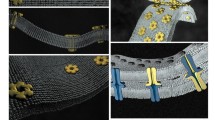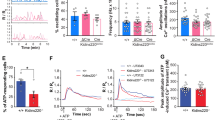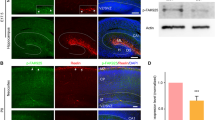Abstract
The gap junction protein, connexin 43 (Cx43), is only present and abundantly expressed in astrocytes but is absent in neurons in the mature brain tissues. However, both the expression and function of Cx43 in neurons during brain embryonic development remain largely unexplored. In the present study, we confirmed that Cx43 is expressed in the migrating neurons in the embryonic stage of the brain. Neuron-specific Cx43 conditional knockout (cKO) using Cre-loxP technique impairs neuronal migration and formation of laminar structure in cerebral cortex during brain embryonic development. The animal behavior tests demonstrated that, at the adult stage, neuronal Cx43 cKO mice exhibit normal learning and memory functions but increased anxiety-like behavior. We also found that during the embryonic development, the gradually decreased Cx43 expression in the cortex is closely correlated with the upregulation of cyclin-dependent kinase 5 (Cdk5) activity. Cdk5 directly phosphorylates Cx43 at Ser279 and Ser282, which, in consequence, inhibits the membrane targeting of Cx43 and promotes its proteasome-dependent degradation. In summary, our findings revealed that the embryonic expression of Cx43 in neurons regulates processes of neuronal migration and positioning in the developing brain by controlling astrocyte-neuron interactions during brain embryonic development, and Cdk5 directly phosphorylates Cx43, which regulates the membrane localization and degradation of Cx43 in neurons.








Similar content being viewed by others
References
Cheng AW, Tang HY, Cai JL, Zhu M, Zhang XY, Rao M, Mattson MP (2004) Gap junctional communication is required to maintain mouse cortical neural progenitor cells in a proliferative state. Dev Biol 272(1):203–216. doi:10.1016/j.ydbio.2004.04.031
Cina C, Maass K, Theis M, Willecke K, Bechberger JF, Naus CC (2009) Involvement of the cytoplasmic C-terminal domain of connexin43 in neuronal migration. J Neurosci 29(7):2009–2021. doi:10.1523/Jneurosci.5025-08.2009
Elias LAB, Wang DD, Kriegstein AR (2007) Gap junction adhesion is necessary for radial migration in the neocortex. Nature 448(7156):901–U903. doi:10.1038/Nature06063
Elias LAB, Kriegstein AR (2008) Gap junctions: multifaceted regulators of embryonic cortical development. Trends Neurosci 31(5):243–250. doi:10.1016/j.tins.2008.02.007
Todd KL, Kristan WB, French KA (2010) Gap junction expression is required for normal chemical synapse formation. J Neurosci 30(45):15277–15285. doi:10.1523/Jneurosci.2331-10.2010
Maher BJ, McGinley MJ, Westbrook GL (2009) Experience-dependent maturation of the glomerular microcircuit. Proc Natl Acad Sci U S A 106(39):16865–16870. doi:10.1073/pnas.0808946106
Sohl G, Willecke K (2004) Gap junctions and the connexin protein family. Cardiovasc Res 62(2):228–232. doi:10.1016/j.cardiores.2003.11.013
Giaume C, Koulakoff A, Roux L, Holcman D, Rouach N (2010) Neuron-glia interactions astroglial networks: a step further in neuroglial and gliovascular interactions. Nat Rev Neurosci 11(2):87–99. doi:10.1038/Nrn2757
Schools GP, Zhou M, Kimelberg HK (2006) Development of gap junctions in hippocampal astrocytes: evidence that whole cell electrophysiological phenotype is an intrinsic property of the individual cell. J Neurophysiol 96(3):1383–1392. doi:10.1152/jn.00449.2006
Niculescu D, Lohmann C (2014) Gap junctions in developing thalamic and neocortical neuronal networks. Cereb Cortex 24(12):3097–3106. doi:10.1093/cercor/bht175
Chever O, Lee CY, Rouach N (2014) Astroglial connexin43 hemichannels tune basal excitatory synaptic transmission. J Neurosci Off J Soc Neurosci 34(34):11228–11232. doi:10.1523/JNEUROSCI.0015-14.2014
May D, Tress O, Seifert G, Willecke K (2013) Connexin47 protein phosphorylation and stability in oligodendrocytes depend on expression of Connexin43 protein in astrocytes. J Neurosci Off J Soc Neurosci 33(18):7985–7996. doi:10.1523/JNEUROSCI.5874-12.2013
Sohl G, Maxeiner S, Willecke K (2005) Expression and functions of neuronal gap junctions. Nat Rev Neurosci 6(3):191–200. doi:10.1038/nrn1627
Arumugam H, Liu X, Colombo PJ, Corriveau RA, Belousov AB (2005) NMDA receptors regulate developmental gap junction uncoupling via CREB signaling. Nat Neurosci 8(12):1720–1726. doi:10.1038/nn1588
Rouach N, Avignone E, Meme W, Koulakoff A, Venance L, Blomstrand F, Giaume C (2002) Gap junctions and connexin expression in the normal and pathological central nervous system. Biol Cell Auspices Eur Cell Biol Organ 94(7-8):457–475
Bennett MVL, Zukin RS (2004) Electrical coupling and neuronal synchronization in the mammalian brain. Neuron 41(4):495–511. doi:10.1016/S0896-6273(04)00043-1
Dermietzel R, Traub O, Hwang TK, Beyer E, Bennett MV, Spray DC, Willecke K (1989) Differential expression of three gap junction proteins in developing and mature brain tissues. Proc Natl Acad Sci U S A 86(24):10148–10152
Stehberg J, Moraga-Amaro R, Salazar C, Becerra A, Echeverria C, Orellana JA, Bultynck G, Ponsaerts R et al (2012) Release of gliotransmitters through astroglial connexin 43 hemichannels is necessary for fear memory consolidation in the basolateral amygdala. FASEB J Off Publ Fed Am Soc Exp Biol 26(9):3649–3657. doi:10.1096/fj.11-198416
Errede M, Girolamo F, Rizzi M, Bertossi M, Roncali L, Virgintino D (2014) The contribution of CXCL12-expressing radial glia cells to neuro-vascular patterning during human cerebral cortex development. Front Neurosci 8:324. doi:10.3389/fnins.2014.00324
Kunze A, Congreso MR, Hartmann C, Wallraff-Beck A, Huttmann K, Bedner P, Requardt R, Seifert G et al (2009) Connexin expression by radial glia-like cells is required for neurogenesis in the adult dentate gyrus. Proc Natl Acad Sci U S A 106(27):11336–11341. doi:10.1073/pnas.0813160106
Ek-Vitorin JF, King TJ, Heyman NS, Lampe PD, Burt JM (2006) Selectivity of connexin 43 channels is regulated through protein kinase C-dependent phosphorylation. Circ Res 98(12):1498–1505. doi:10.1161/01.RES.0000227572.45891.2c
Solan JL, Lampe PD (2008) Connexin 43 in LA-25 cells with active v-src is phosphorylated on Y247, Y265, S262, S279/282, and S368 via multiple signaling pathways. Cell Commun Adhes 15(1):75–84. doi:10.1080/15419060802014016
Beffert U, Weeber EJ, Morfini G, Ko J, Brady ST, Tsai LH, Sweatt JD, Herz J (2004) Reelin and cyclin-dependent kinase 5-dependent signals cooperate in regulating neuronal migration and synaptic transmission. J Neurosci Off J Soc Neurosci 24(8):1897–1906. doi:10.1523/JNEUROSCI.4084-03.2004
Ohshima T, Ward JM, Huh CG, Longenecker G, Veeranna, Pant HC, Brady RO, Martin LJ et al (1996) Targeted disruption of the cyclin-dependent kinase 5 gene results in abnormal corticogenesis, neuronal pathology and perinatal death. Proc Natl Acad Sci U S A 93(20):11173–11178
Gilmore EC, Ohshima T, Goffinet AM, Kulkarni AB, Herrup K (1998) Cyclin-dependent kinase 5-deficient mice demonstrate novel developmental arrest in cerebral cortex. J Neurosci Off J Soc Neurosci 18(16):6370–6377
Ohshima T, Hirasawa M, Tabata H, Mutoh T, Adachi T, Suzuki H, Saruta K, Iwasato T et al (2007) Cdk5 is required for multipolar-to-bipolar transition during radial neuronal migration and proper dendrite development of pyramidal neurons in the cerebral cortex. Development 134(12):2273–2282. doi:10.1242/dev.02854
Gupta A, Sanada K, Miyamoto DT, Rovelstad S, Nadarajah B, Pearlman AL, Brunstrom J, Tsai LH (2003) Layering defect in p35 deficiency is linked to improper neuronal-glial interaction in radial migration. Nat Neurosci 6(12):1284–1291. doi:10.1038/nn1151
Hammond V, Tsai LH, Tan SS (2004) Control of cortical neuron migration and layering: cell and non cell-autonomous effects of p35. J Neurosci Off J Soc Neurosci 24(2):576–587. doi:10.1523/JNEUROSCI.4529-03.2004
Ohshima T, Mikoshiba K (2002) Reelin signaling and Cdk5 in the control of neuronal positioning. Mol Neurobiol 26(2-3):153–166. doi:10.1385/MN:26:2-3:153
Dhavan R, Tsai LH (2001) A decade of CDK5. Nat Rev Mol Cell Biol 2(10):749–759. doi:10.1038/35096019
Songyang Z, Lu KP, Kwon YT, Tsai LH, Filhol O, Cochet C, Brickey DA, Soderling TR et al (1996) A structural basis for substrate specificities of protein Ser/Thr kinases: primary sequence preference of casein kinases I and II, NIMA, phosphorylase kinase, calmodulin-dependent kinase II, CDK5, and Erk1. Mol Cell Biol 16(11):6486–6493
Pannasch U, Vargova L, Reingruber J, Ezan P, Holcman D, Giaume C, Sykova E, Rouach N (2011) Astroglial networks scale synaptic activity and plasticity. Proc Natl Acad Sci U S A 108(20):8467–8472. doi:10.1073/pnas.1016650108
Lutz SE, Zhao YM, Gulinello M, Lee SC, Raine CS, Brosnan CF (2009) Deletion of astrocyte connexins 43 and 30 leads to a dysmyelinating phenotype and hippocampal CA1 vacuolation. J Neurosci 29(24):7743–7752. doi:10.1523/Jneurosci.0341-09.2009
Han Y, Yu HX, Sun ML, Wang Y, Xi W, Yu YQ (2014) Astrocyte-restricted disruption of connexin-43 impairs neuronal plasticity in mouse barrel cortex. Eur J Neurosci 39(1):35–45. doi:10.1111/ejn.12394
Hatten ME (1999) Central nervous system neuronal migration. Annu Rev Neurosci 22:511–539. doi:10.1146/annurev.neuro.22.1.511
Marin O, Rubenstein JL (2003) Cell migration in the forebrain. Annu Rev Neurosci 26:441–483. doi:10.1146/annurev.neuro.26.041002.131058
Valiente M, Marin O (2010) Neuronal migration mechanisms in development and disease. Curr Opin Neurobiol 20(1):68–78. doi:10.1016/j.conb.2009.12.003
Huang GY, Cooper ES, Waldo K, Kirby ML, Gilula NB, Lo CW (1998) Gap junction-mediated cell-cell communication modulates mouse neural crest migration. J Cell Biol 143(6):1725–1734
Fushiki S, Perez Velazquez JL, Zhang L, Bechberger JF, Carlen PL, Naus CC (2003) Changes in neuronal migration in neocortex of connexin43 null mutant mice. J Neuropathol Exp Neurol 62(3):304–314
Cina C, Bechberger JF, Ozog MA, Naus CC (2007) Expression of connexins in embryonic mouse neocortical development. J Comp Neurol 504(3):298–313. doi:10.1002/cne.21426
de Kloet ER, Joels M, Holsboer F (2005) Stress and the brain: from adaptation to disease. Nat Rev Neurosci 6(6):463–475. doi:10.1038/nrn1683
Winckler B (2007) BDNF instructs the kinase LKB1 to grow an axon. Cell 129(3):459–460. doi:10.1016/j.cell.2007.04.021
Arimura N, Kaibuchi K (2007) Neuronal polarity: from extracellular signals to intracellular mechanisms. Nat Rev Neurosci 8(3):194–205. doi:10.1038/nrn2056
Tokuoka H, Saito T, Yorifuji H, Wei F, Kishimoto T, Hisanaga S (2000) Brain-derived neurotrophic factor-induced phosphorylation of neurofilament-H subunit in primary cultures of embryo rat cortical neurons. J Cell Sci 113(Pt 6):1059–1068
Zhao CT, Li K, Li JT, Zheng W, Liang XJ, Geng AQ, Li N, Yuan XB (2009) PKCdelta regulates cortical radial migration by stabilizing the Cdk5 activator p35. Proc Natl Acad Sci U S A 106(50):21353–21358. doi:10.1073/pnas.0812872106
Baumann K, Mandelkow EM, Biernat J, Piwnica-Worms H, Mandelkow E (1993) Abnormal Alzheimer-like phosphorylation of tau-protein by cyclin-dependent kinases cdk2 and cdk5. FEBS Lett 336(3):417–424
Niethammer M, Smith DS, Ayala R, Peng JM, Ko J, Lee MS, Morabito M, Tsai LH (2000) NUDEL is a novel Cdk5 substrate that associates with LIS1 and cytoplasmic dynein. Neuron 28(3):697–711. doi:10.1016/S0896-6273(00)00147-1
Xie ZG, Sanada K, Samuels BA, Shih H, Tsai LH (2003) Serine 732 phosphorylation of FAK by Cdk5 is important for microtubule organization, nuclear movement, and neuronal migration. Cell 114(4):469–482. doi:10.1016/S0092-8674(03)00605-6
Kawauchi T, Chihama K, Nabeshima Y, Hoshino M (2006) Cdk5 phosphorylates and stabilizes p27kip1 contributing to actin organization and cortical neuronal migration. Nat Cell Biol 8(1):17–26. doi:10.1038/ncb1338
Nishimura YV, Shikanai M, Hoshino M, Ohshima T, Nabeshima Y, Mizutani K, Nagata K, Nakajima K et al (2014) Cdk5 and its substrates, Dcx and p27kip1, regulate cytoplasmic dilation formation and nuclear elongation in migrating neurons. Development 141(18):3540–3550. doi:10.1242/Dev.111294
Acknowledgments
This work was supported financially by the National Natural Science Foundation of China (Nos. 31071208, 31371384, 30900423 to B.T.) and Program for New Century Excellent Talents in University (No. NCET-10-0415 to B.T.).
Conflict of Interest
The authors declare that there are no conflicts of interest.
Author information
Authors and Affiliations
Corresponding author
Additional information
Guang-Jian Qi and Qiang Chen contributed equally to this work.
Electronic supplementary material
Below is the link to the electronic supplementary material.
Supplementary Figure 1
The protein levels of Cx43 in primary culture neurons in 3 or 12 days in vitro. The protein levels of Cx43 in primary cultured neurons of DIV3 (3 days in vitro) and DIV12 were measured using Western blotting. β-tubulin was used as a loading control. (PDF 47 kb)
Supplementary Figure 2
Cx43 is expressed on cell membrane of neurons in the embryonic brain. Double-immunofluorescence staining was conducted with antibodies against Cx43 (red), cytosolic neuronal marker β-III-tubulin (green) on the brain slices from the E16.5 rat embryo, and nuclei were labelled with DAPI (blue). Scale bar: 50 μm. (PDF 105 kb)
Supplementary Figure 3
Adult neuronal Cx43 knockout mice exhibit relatively normal morphological structure in the brain. (a) Morphological structure of the brains in wild type (WT) and neuronal Cx43 cKO (KO) mice at age of 12 weeks was observed by histological examination using hematoxylin and eosin staining. CX: cerebral cortex; HP: hippocampus; AM: amygdala. (b) laminar structure of the cerebral cortex. (c) The structure pattern of hippocampus. (PDF 140 kb)
Supplementary Figure 4
The degradation pathway of endogenous Cx43 in neurons with BDNF stimulation. The primary cultured neurons from E14.5 rat embryo were used on day 3 in vitro. Protein synthesis was blocked by cycloheximide (CHX) to show the endogenous Cx43 degradation. The neurons were stimulated by BDNF (100 ng/ml), with or without proteasome inhibitor MG132, for 4 h. (a) Endogenous Cx43 levels were measured by Western blot. (b) Statistical analysis of the levels of endogenous Cx43 treated with autophagy or proteasome inhibitor. Values are means ± SEM of 3 individual experiments. *P < 0.05. (PDF 56 kb)
Rights and permissions
About this article
Cite this article
Qi, GJ., Chen, Q., Chen, LJ. et al. Phosphorylation of Connexin 43 by Cdk5 Modulates Neuronal Migration During Embryonic Brain Development. Mol Neurobiol 53, 2969–2982 (2016). https://doi.org/10.1007/s12035-015-9190-6
Received:
Accepted:
Published:
Issue Date:
DOI: https://doi.org/10.1007/s12035-015-9190-6




